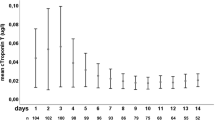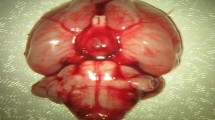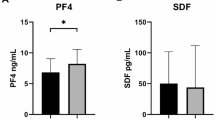Abstract
Study design
Animal proof of principle study.
Objectives
To investigate neurodegeneration in rabbit L4-dorsal root ganglion (DRG) cells by creating experimental spinal subarachnoid hemorrhage (SAH), we aimed to show the neuronal pathway between L4-DRG and femoral artery.
Setting
Ataturk University, Medical Faculty, Animal Laboratory, Erzurum, Turkey.
Methods
This study was designed on 20 rabbits, which were randomly divided into three groups: Spinal SAH (n = 8), SHAM (n = 6), and control (n = 6) groups. Animals were followed for 20 days and then killed. Vasospasm index values of the femoral artery and neuron density of L4-DRG were analyzed.
Results
The number of degenerated neurons in DRG was higher in the spinal SAH than the control and SHAM groups (p < 0.001). But, the difference between the control group and the SHAM group was not significant. Normal neuron densities were significantly lower in the spine SAH group compared to the SHAM and the control groups. There was a statistically significant increase in vasospasm index values of the spinal SAH group compared to the other two groups (p < 0.001).
Conclusions
Decreased volume of the femoral artery lumen was showed in animals with spinal SAH compared with control and SHAM groups. Increased degeneration of the L4 dorsal root ganglion in animals with spinal SAH was also demonstrated. Our findings might shed light on the planning of future experimental studies and evaluating the clinical relevance of such studies.
Similar content being viewed by others
Log in or create a free account to read this content
Gain free access to this article, as well as selected content from this journal and more on nature.com
or
Data availability
Further data, is available from all author.
References
Kim KS, Brophy GM. Symptomatic venous thromboembolism: incidence and risk factors in patients with spontaneous or traumatic intracranial hemorrhage. Neurocrit Care. 2009;11:28–33.
Tuzgen S, Kucukyuruk B, Aydin S, Ozlen F, Kizilkilic O, Abuzayed B, et al. Decompressive craniectomy in patients with cerebral infarction due to malignant vasospasm after aneurysmal subarachnoid hemorrhage. J Neurosci Rural Pract. 2012;3:251–5.
Findlay JM, Nisar J, Darsaut T. Cerebral vasospasm: a review. Can J Neurol Sci. 2016;43:15–32.
Turkmenoglu ON, Kanat A, Yolas C, Aydin MD, Ezirmik N, Gundogdu C, et al. First report of important causal relationship between the Adamkiewicz artery vasospasm and dorsal root ganglion cell degeneration in spinal subarachnoid hemorrhage: An experimental study using a rabbit model. Asian J Neurosurg. 2017;12:22–7.
Ozturk C, Kanat A, Aydin MD, Yolas C, Kabalar ME, Gundogdu B, et al. The impact of L5 dorsal root ganglion degeneration and Adamkiewicz artery vasospasm on descending colon dilatation following spinal subarachnoid hemorrhage: an experimental study; first report. J Craniovertebr Junction Spine. 2015;6:69–75.
Onder A, Serarslan Y, Aydin MD, Kanat A, Gursan N, Yolas C, et al. Spinal arachnoiditis and the axonal degeneration of the spinal nerve roots due to ischemia induced by vasospasm: an experimental study. J Neurol Sci Turk. 2009;26:416–23.
Kanat A, Yilmaz A, Aydin MD, Musluman M, Altas S, Gursan N, et al. Role of degenerated neuron density of dorsal root ganglion on anterior spinal artery vasospasm in subarachnoid hemorrhage: experimental study. Acta Neurochir. 2010;152:2167–72.
Kayacı S, Cakir T, Aydin MD, Kanat A, Omeroglu M, Levent A, et al. Brachial artery vasospasm caused by cervical dorsal root ganglion degeneration after subarachnoid hemorrhage: an experimental study. World Neurosurg. 2019;126:895–900.
Xing J, Lu J, Li J. Augmented P2X response and immunolabeling in dorsal root ganglion neurons innervating skeletal muscle following femoral artery occlusion. J Neurophysiol. 2013;109:2161–8.
Kuipers R, Izhar Z, Gerrits PO, Miner W, Holstege G. Location of bladder and urethral sphincter motoneurons in the male guinea pig (Cavia porcellus). Neurosci Lett. 2004;362:57–60.
Xing J, Li J. TRPA1 function in skeletal muscle sensory neurons following femoral artery occlusion. Cell Physiol Biochem. 2017;42:2307–17.
Karadeniz E, Caglar O, Firinci B, Ahiskalioglu A, Aydin MD, Kocak MN, et al. Predeterminative role of Onuf’s nucleus ischemia on mesenteric artery vasospasm in spinal subarachnoid hemorrhage: A preliminary experimental study. Asian J Surg. 2019;42:797–804.
Caglar O, Firinci B, Aydin ME, Arslan R, Kanat A, Demirci T, et al. First emerging evidence of the relationship between Onuf’s nucleus degeneration and reduced sperm number following spinal subarachnoid haemorrhage: experimental study. Andrologia. 2021;53:e14030.
Ray P, Torck A, Quigley L, Wangzhou A, Neiman M, Rao C, et al. Comparative transcriptome profiling of the human and mouse dorsal root ganglia: an RNA-seq-based resource for pain and sensory neuroscience research. Pain. 2018;159:1325–45.
Kikuchi S, Sato K, Konno S, Hasue M. Anatomic and radiographic study of dorsal root ganglia. Spine. 1994;19:6–11.
Mazensky D, Radonak J, Danko J, Petrovova E, Frankovicova M. Anatomical study of blood supply to the spinal cord in the rabbit. Spinal Cord. 2011;49:525–8.
Author information
Authors and Affiliations
Corresponding author
Ethics declarations
Competing interests
The authors declare no competing interests.
Ethics approval
All procedures performed on animals were in accordance with the ethical standards of the Integrated Laboratory Systems animal care and use committees and followed the NIH Guidelines for the Care and Use of Laboratory Animals. We certify that all applicable institutional and governmental regulations concerning the ethical use of animals were followed during the course of this research. This article does not contain any studies with human participants.
Additional information
Publisher’s note Springer Nature remains neutral with regard to jurisdictional claims in published maps and institutional affiliations.
Supplementary information
Rights and permissions
About this article
Cite this article
Cetin, A., Ozevren, H., Arslan, R. et al. Assessment relationship between the femoral artery vasospasm and dorsal root ganglion cell degeneration in spinal subarachnoid hemorrhage: an experimental study. Spinal Cord 60, 404–407 (2022). https://doi.org/10.1038/s41393-022-00778-x
Received:
Revised:
Accepted:
Published:
Issue date:
DOI: https://doi.org/10.1038/s41393-022-00778-x



